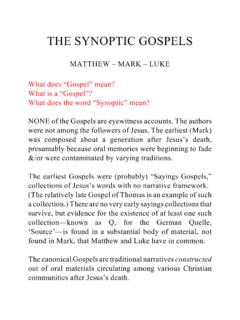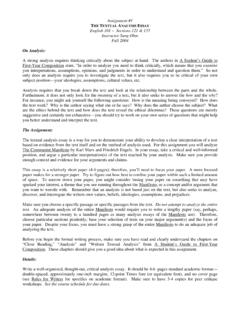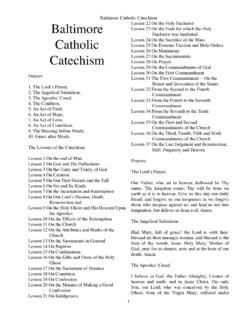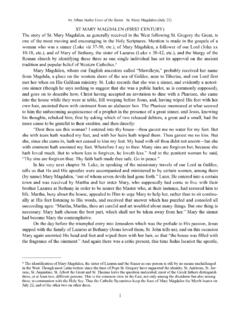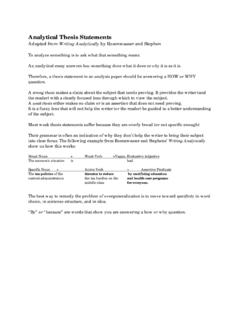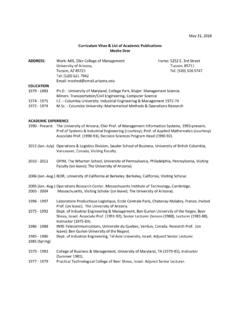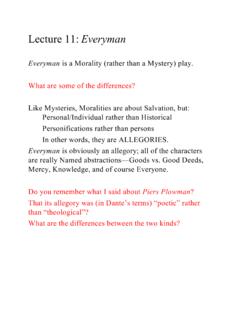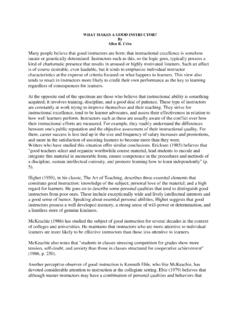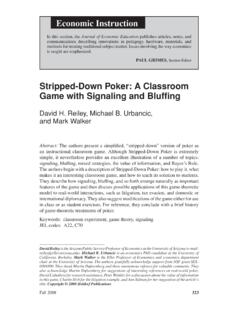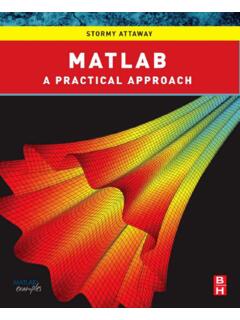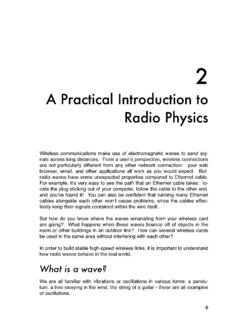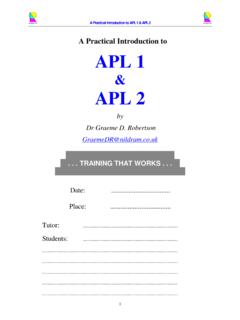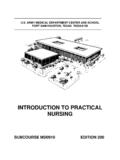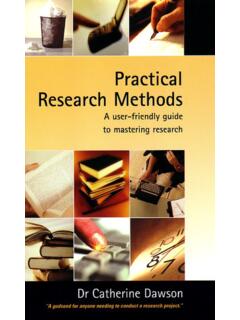Transcription of Z KÖVECSES Metaphor: A practical introduction
1 1 ZOLT N K vecses , metaphor : a practical introduction . New York: Oxford University Press, 2002. Pp. xvi, 285. Pb. $ Reviewed by CHIENJER CHARLES LIN Anthropology and Linguistics, University of Arizona Tucson, AZ 85721 This is the first textbook on metaphor after the cognitive linguistic revolution of metaphorical research launched by Lakoff and Johnson with their pioneering work, Metaphors We Live By, two decades ago. Much scholarship has since then been devoted to this paradigm of research. Twenty years have passed; K vecses takes it as a good time to summarize the development of the field. Writing a textbook on metaphor certainly reflects the maturation of the field. As the title suggests, this book aims to introduce what has been discovered about metaphors in the cognitive linguistic tradition.
2 Targeted readers are undergraduate and graduate students with interests in metaphor and cognitive linguistics. Experienced researchers may also find this book helpful in motivating new ideas. As a practicing cognitive and cultural linguist, K vecses manages to introduce various aspects of the contemporary theory of metaphor , providing readers with rich linguistic examples from different languages. Topics include the linguistic, cognitive, psychological and cultural aspects of metaphor . This book gives neophytes a picture of what sorts of metaphorical research has been done and what research possibilities are still out there. Many of the examples in this book (especially metaphors of emotion) are from K vecses own work; examples from other researchers and from languages other than English also abound.
3 2 metaphor comes in 17 chapters. Each chapter is of reasonable length the longest chapter is 22 pages long; most chapters are around 15 pages. Every chapter has a summary, a list of recommended readings, and exercises following the main text. The author also provides a glossary and solutions to the exercises at the end of the book. In addition to a general index, there is an index for metaphors and metonymies. Chap. 1 introduces what metaphor is. It distinguishes between linguistic and conceptual metaphors (CMs) and defines the scope of the book. Section 5 of this chapter contains a list of questions that are to be answered in subsequent chapters. Each set of questions summarize what one chapter is about. These questions are intended to give readers an overview of the book.
4 However, as these questions are extremely detailed, their appearance in the first chapter may be overwhelming for unprepared readers. It would be more helpful if K vecses kept this section a simple summary of each chapter, while placed the questions at the beginning of each chapter as a studying guide. Chap. 2 surveys common source domains (SDs) and target domains (TDs). The reversibility of SD-to-TD mapping is also discussed. K vecses allows reverse mappings from TD to SD (p. 25), which seems to be an unnecessary concession. When SD and TD are reversible, it simply means that certain conceptual domains could be SDs sometimes and TDs in other times. That is, a concept that acts as an SD in one CM can be a TD in another. It should therefore be retained that an SD is always used to understand a TD; this direction is irreversible.
5 What should be allowed for will be that TDs are not always more abstract than SDs. Chap. 3 categorizes metaphors based on their conventionality ( novel vs. conventional), cognitive functions ( structural, ontological, or orientational), nature ( knowledge-based vs. image-based), and levels of generality ( generic vs. specific). The term 3 cognitive function may be a bit misleading as it is not transparent whether categorizing metaphors into structural, ontological, and orientational reflects the different functions of these metaphors at the cognitive level. A neutral term cognitive basis of metaphors may be a better choice. Chaps. 4 and 5 look at the realization of metaphors in literature and nonlinguistic media. Chap. 4 looks at metaphors in literature, particularly poetic metaphors.
6 K vecses shows that literary metaphors are primarily based on similar CMs that generate metaphors in daily language. Chap. 5 looks at how metaphors are commonly used in movies, cartoons, advertisements, etc. Chaps. 6-9 look at the mappings between SDs and TDs. Chap. 6 explains why certain SDs are mapped onto certain TDs. Four relations between SDs and TDs are suggested: correlations in experience, perceived structural similarity, biological or cultural root, and preexisting similarity. Chap. 7 and 8 explain how only certain parts of SDs are mapped onto TDs. Chap. 9 explores how one SD is adopted for various TDs. In these chapters, K vecses shows that the relations between SDs and TDs are many-to-many; that is, one SD could be mapped onto various TDs, and different SDs could be mapped onto one TD.
7 K vecses explains that primary metaphors ( metaphors that are based on correlations in experience) which compose complex metaphors motivate certain elements in the SD to map onto the TD. It, however, remains rather obscure whether an unambiguous definition of domain is possible to make. The difficulty of delimiting domains is especially evident when it comes to multiple SDs being mapped onto one TD. Are these SDs of distinct domains? Are they subdomains of some larger unified knowledge or semantic field? Are they mental concepts? What is the scope of a mental concept? Could these conceptual domains be merely translations of different lexical items? These questions shoot essentially at the definition of a CM, which is established based on a collection of linguistic 4metaphors, and named using a meta-language, which, in this book, happens to be English.
8 The scope of a domain is vague. This is a basic unsettled problem concerning the relation between language and thought. K vecses could have acknowledged these difficulties. Chap. 10 further categorizes metaphor systems into those based on things (Great Chain Metaphors) and those based on relations (Event Structure Metaphors). Chap. 11 introduces metonymy and Idealized Cognitive Models. Chaps. 12 and 13 discuss the universality and cultural specificity of metaphors. Data from various languages ( Hungarian, Japanese, Zulu, Chinese, etc.) are drawn. Metaphorical universality is based on common bodily experiences; variations are found both across cultures and within a single culture (over time). On p. 184, K vecses tries to associate language (linguistic metaphor ) with cultural behaviors ( characters of speakers).
9 Correspondences between language, culture, and behavior are appealing claims to make. It would be more convincing, however, if such claims were made with empirical evidences ( from psychological experiments). Chaps. 14 and 15 relate the study of metaphor to other linguistic studies. Chap. 14 deals with the conceptual basis of idioms and the implications for foreign language teaching. Chap. 15 discusses metaphor , polysemy, historical semantics, and other grammatical phenomena. These two chapters place metaphorical studies within the larger linguistic enterprise. They show that the study of metaphor is not isolated; instead, it has implications for other issues in linguistics. This book introduces most of the fundamental concepts in the first 15 chapters. Chap. 16 continues to introduce the state-of-the-art development of metaphorical theory: the Network Model (also known as the blending theory) proposed by Fauconnier and Turner (2002).
10 This theory focuses on the on-line understanding of metaphors how imagination works. metaphor is seen as one of the many relations that exist among domains. Chap. 17 recapitulates previous 5chapters, placing studies of metaphor at three levels: the superindividual level studies conventionalized linguistic metaphors; the individual level looks at the neural and psychological reality of metaphors; the subindividual level focuses on the underlying physiological basis of metaphor . Readers may find classifications of metaphors confusing in this book. This is because metaphorical research has been, to some extent, diverse; it gets rather intricate if one attempts to group what has been done. One important question that K vecses has not dealt with at length is the relation between metaphor and analogy.
